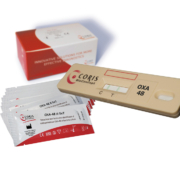Accurate, fast and low-cost CPE detection
The rapid detection of antimicrobial resistance represents a major challenge for hospitals. Lateral flow immunochromatographic assays developed by Coris BioConcept are the ideal solution to save time, money and lives.
Enterobacteriaceae are Gram-negative bacteria mostly naturally living in our intestine. They are also largely described in serious infections such as sepsis, peritonitis, cystitis or pneumonia, often acquired in a healthcare environment such as the hospital. Antibiotics from the beta-lactam family are commonly used to treat those nosocomial infections. However, regarding their ability to adapt to any changing environment, bacteria have developed lots of mechanisms to counteract the action of beta-lactam molecules, such as the production of enzymes able to specifically hydrolyse them. These so-called beta-lactamases are typically found in Pseudomonas aeruginosa, Klebsiella pneumoniae, Escherichia coli and many other bacteria. They confer a high level of resistance to a wide range of beta-lactam type of antibiotics. To face those resistant strains, carbapenems have been successfully used for years as the last resort medicine. However, carbapenemase-producing enterobacteriaceae (CPE) have now emerged, expressing new hydrolysis enzymes to deactivate carbapenem-like molecules. CPE outbreaks in healthcare facilities leave few alternative antimicrobial solutions and are therefore often associated with morbidity, mortality and tremendous care costs.
Fast identification of carbapenemases
Different types of carbapenemases have been described all over the world, the most worrying one being variants from the OXA-48, KPC, NDM and VIM families. Like described for other resistance, those bacterial enzymes are encoded by genes present on extra-chromosomal plasmids. This facilitates exchanges between Gram-negative bacteria and explains the successful worldwide transmission of those dangerous carbapenemases. Patients carrying and/or having clinical infections with CPE can be considered as reservoirs for transmission to other patients. Since warning campaigns from multiple global health organizations, almost every country in the world has now drawn up governmental guidelines for a proper control and management of CPE infections in hospitals.
As soon as identified, resistant strains should be quickly contained to avoid any spreading outside the facility, and the medication should be adapted for the recovery of the patient. A rapid detection of CPE at the clinical laboratory level is therefore essential to prevent infection spreading, isolate the facility and cure the patient. To this end, microbiological culture is largely used because of its simplicity and low cost. However, antimicrobial resistance profiles have been more and more variable and complicated to interpret, forcing laboratories to increase the amount of analyses and consequently the time to result. Confirmatory CPE phenotypic tests have emerged during the recent years, like colorimetric-based tests. But still they do not allow the precise identification of the carbapenemase type, are difficult to interpret, and require an additional day following the first culture. Mass spectrometry-based methods for routine CPE detection are not yet conventionally used since they require access to dedicated instruments. Decrypting antimicrobial resistance at the DNA level using molecular techniques is another solution, but unfortunately not available in every laboratory due to extra costs, time and staff required.
Rapid diagnostic solutions
Alternatively, the Belgian company Coris BioConcept has developed a range of lateral flow assays to help microbiological laboratories speed identifications of resistant strains. Those tests, named “RESIST” are available in the market since 2015. The novelty of the RESIST tests lies in the precise identification of carbapenemase proteins using specific monoclonal antibodies. Lateral flow assays are fast, providing results in less than 15 minutes directly after bacterial isolation on primary microbiological cultures. Moreover, results can be read with the naked eye, meaning that no specific equipment is required. This technology is also low cost and easy to handle.
Since RESIST tests have proven high performances (100% specificity and sensibility), they are nowadays highly recommended by Reference Laboratories for routine CPE analysis. Covering all variants from the 4 main OXA-48, KPC NDM and VIM carbapenemase families, RESIST tests have opened access to accurate, fast and cost-effective solutions for the identification of CPE’s. Today, the RESIST line includes up to 5 different single and multiplex CPE detection kits and is likely to expand in tests for the detection of other clinically important resistance mechanisms in Gram-Positive and Gram-Negative bacteria. Also complementary to primary microbiological cultures, Coris is progressing on using those rapid tests directly from patient samples in order to screen incoming patients and to shorten the time to CPE detection and consequently allow a faster and more efficient control and management of outbreaks in every healthcare facility around the world.
www.corisbio.com


